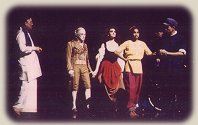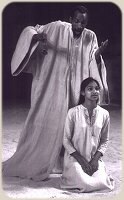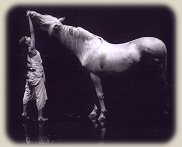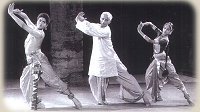
|
 |

|
 |
SHANTALA SHIVALINGAPPA - Lalitha Venkat, Chennai e-mail: lalvenkat@yahoo.com Oct 2001  Born in India, brought up in Paris, Shantala grew in a world filled with dance and music, initiated at a tender age by her mother, dancer Savitry Nair from whom she learnt Bharatanatyam. Inspired by Kuchipudi guru Vempatti Chinna Satyam's pure and graceful style, Shantala dedicated herself to Kuchipudi and had her Kuchipudi arangetram at the Kalakshetra Auditorium, Chennai in 1993. She has performed with his troupe all over the world. Since the age of 13, she has also had the privilege of working with some of the greatest artists of our times: Maurice Bejart (as dance soloist in the ballet "1789...et nous" for the bi-centenary celebrations of the French Revolution in 1989); Peter Brook (1990-91 in the role of Miranda in Shakespeare's "The Tempest" performed in Paris at the Bouffes du Nord theater, across Europe and in Tokyo; In 2000-01 as Ophelia in Shakespeare's "Hamlet" performed at the Bouffes du Nord, Paris, and currently on a world tour); Bartabas (1994-96 as dance soloist in Zingaro company's production "Chimere", performed extensively across Europe and in New York for the BAM New-Wave Festival in 1996); and Pina Bausch (1999 as guest dancer in Pina Bausch's new production, "O Dido"). In 1998, she played a dancer in the French classical play "Surena" by Coreille, directed by Anne Delbee for the Comedie Francaise (National Theater Company of Paris). Such experiences make her artistic journey a truly unique one. Shantala has done her masters in Ethnology from Paris and her thesis was on “Gurukulam” for which she did her fieldwork with Vempatti Chinna Sathyam's dance school.  Living in Paris since you were 6 months old and having your mother's guidance must have given you easy entry into the dance circle in Europe. I could say so. I went to Paris in 1976. My parents were already settled there. My dad was working in UNESCO. My mother taught in Paris, did a lot of workshops in theatre companies and ballet schools. She was teaching in Maurice Bejart's school Mudra in Brussels. She used to go there quite often and took me along too. I didn't develop a big passion for dancing till I was 16 and started dancing Kuchipudi. I used to dance only Bharatanatyam till then. My mother did a contemporary choreography for 'Trikonam' in '91 for the Dance Umbrella Festival in London. It featured a Bharatanatyam dancer, a ballet dancer and I performed in the Kuchipudi style. It was the story of Bhasmasura where I did the role of Shiva. Since my mother wanted me to present the Kuchipudi variation, she sent me to Chennai to learn under Guru Vempati Chinna Satyam whose son Ravi taught me. Things progressed one after another quite smoothly, mostly thanks to my mother already being an established artiste. A lot of people knew her. I also started quite early. My first tour was all through friends' contacts and it was mobilized easily through my mother knowing and working with so many people already.  You were very young when you were selected to take part in Maurice Bejart's ballet "1789...et nous". Maurice Bejart had seen me dance as a child. For the bicentenary of the French revolution, he wanted to represent the different continents and had the idea of an Indian dancer to represent India. He has done a lot of work with Indian dance and music. Seetharama Sharma came to Paris to do the nattuvangam and singing. The stage was so huge - Grand Palais. When converted, it was so massive that it took a few minutes just to walk across the stage. That was the first production that I ever participated in. It was in 1989 and I was only 13. I was part of a great company, about 40 to 50 dancers, all ballet performers; I was overcome with awe and admiration of their skills. To be part of that production was a great feeling. Have you trained in Western ballet? I've had no formal training in ballet, but I observed all the rehearsals keenly when I accompanied my mother. I used to come home and try out movements. Maybe a few classes in contemporary dancing with some friends but I have never done classical ballet. The only contemporary dance I've done is with Pina Bausch. That's free movement, but the same time, there's a strong classical base. I've never had any Western classical dance training. With the Pina Bausch Company, I used to take classes with them to get the feel of the movements. Pina Bausch knows my mother and me for a long time. She saw me dance in a theatre in Germany. She said it would be nice if I could dance with her Company and it materialized one day. I was so thrilled.  You have worked with Peter Brook in 'Tempest' (as Miranda) and lately as Ophelia in 'Hamlet'. How different has theatre experience been in comparison to your dance experience? My mother had worked with him earlier in 'Mahabharata'. In fact, my brother rehearsed for a whole year as the little boy who asks the questions but he did not actually perform on stage. Brook's assistant had seen me around and remembered me and I was thus invited to take part in the Tempest. I was 14 then, so I hadn't a clue. 'Tempest' was in French, 'Hamlet' in English. Peter Brook's way of working is very physical. That is, when we rehearse, we spend the first 2 hours doing things that have nothing to do with the play like movement, singing, drumming and so on. It was a very different experience in the sense that in dance, I knew the medium, but I had no clue here. I had no training as an actress. Dance training gives stage presence, body language, and alertness, how you move can convey so much. Ophelia's role was more difficult than Miranda, which was more like what I was at that age - young and innocent. Discovering words, the power of words, the play of words, the reaction to each other's words was added to the body movements. The suggestions he gave had a great affinity to dancing. For Ophelia, when she's mad, the emotions move from one to another, the one basic emotion of 'sthayibhava' had to stay and link one expression to the other. I would say, the inner process, the inner link, the concentration is the same. It was surprising to find that out. I learnt a lot from other actors. Peter is clear and to the point and that's one of his greatest assets. He's so intelligent; he's able to translate what he wants perfectly into words. It makes so much sense.  It must have been fun working with the horses in 'Chimere', and so very different. The equestrian company Zingaro did an Indian show in 1994 that was a big hit. The Rajasthani musicians were so good, the whole audience was mesmerized. 'Chimere' is a mythological creature, also something that can't be touched. The production had Indian colors, costumes and music, but western artistes and acrobats. The horses were the central characters. In one scene, I dance and a male dancer does a few movements seated on the horse. In yet another scene, I dance and beckon to the horse who comes onto the stage and so on. A very different production. The horses were very clever and well trained. They knew well the difference between rehearsal and the actual program. In rehearsals, they did everything perfectly and the opposite on stage in the actual performance. They knew we could tell them off during rehearsals but not during a stage show!! You perform Kuchipudi, modern dance and act in theatre productions as well. How do you transform yourself according to the medium? I don't transform myself; it's the medium that changes. I transport myself to wherever I am, the place, the surroundings. For example, for Pina Bausch, I'll do my stretch exercises, for theatre I'll do my voice training; that way I prepare myself physically in accordance to what I do. Since now I'm preparing to do a Kuchipudi recital, I concentrate more on that but I still do my stretch exercises and voice training. So I do a little bit of everything. How do you rate the status of Indian classical dance in Europe now, especially in France? Years back, my mother taught in schools, performed in churches and small spaces. I would say she put Indian dance on the map of France. People love India, Indian dance, music, food, clothes, color and culture. Especially in France, there's a great love for India, so it's nice being in France. So many Indian programs take place here, big programs. There's a seasoned audience who go to see their favorite dancers and musicians and there's the general audience, which is interested. Europe is very good for Indian culture, very supportive and welcoming. Western Europe is a good place to be. Do you use recorded music for your Indian classical dance performances in Europe? I take the musicians from Chennai. If it's an isolated performance and finance is available, I take the troupe with me. I have a show on November 5th; it is a half hour program, so I'm taking recorded music. I think half the beauty of an Indian dance performance is in the music; it's a whole package. So I prefer a live orchestra. Otherwise, I work to create a few small programs. You are quite a linguist, what languages do you speak? French and English are my 2 good languages. I speak Tamil, Malayalam and some Kannada. Also Spanish and Italian. I have knowledge of German and Hindi.  At this stage in your career, is there anything particular you wish for? I've danced with master's (Vempatti Chinna Sathyam) troupe in a few places, mostly in Chennai. I would really love to perform in India, especially in Chennai, because I consider it my second home. I spend 3 - 4 months a year in Chennai. I don't really know North India; I've never been there. I'd love to be a part of the dance scene in India. Not be known just as an Indian dancer based abroad who wants to perform here. This feeling is quite strong in me now. But the style of functioning here is different; I'm not familiar with it and it's definitely not a help. In France, the people know about me, I'm invited to perform, I'm established. Over there, I can go armed with my bio and performance tapes and request for performance opportunities. Based on my credentials, I get work. The organisers look after you, they pay for everything. It doesn't work that way here. You need contacts here to be in the milieu, not very professional, very different here. If you're not known, you don't get invited to dance here. So it's a bit difficult to survive here as a dancer, I think. This is what I've heard, not experienced it myself. Apart from dance and theatre, what are your other interests? I love Kalari. I've been learning Kalari for the past 3 years. My Kalari masters Binoy and Shaji are so good. Just to see their work and work with them is so inspiring. They are fantastic artistes themselves and generous teachers. I learnt Kalari from Binoy when he was in Chennai. Now he has moved to Paris, I learn from him there. With so many achievements already, what do you look forward to now? There's more in every line. I've worked with so many great artistes. Even then, there's so much more to do in theatre and dance is endless. You feel you've achieved something, but you find when you come to it that there's more to achieve. After this whole year of doing Hamlet, I've fallen for acting and I'd like to do more. Since I've been away from dancing for a year, I'd like to dance again. |